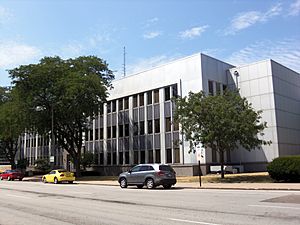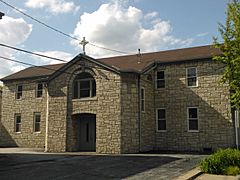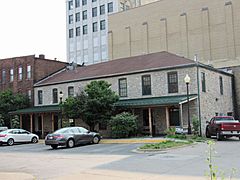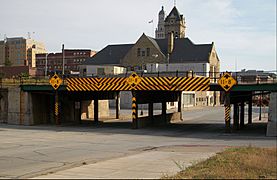Davenport Downtown Commercial Historic District facts for kids
Quick facts for kids |
|
|
Davenport Downtown Commercial Historic District
|
|

Davenport Commercial Club (1905)
|
|
| Location | 2nd St. to 5th St., Perry St. to Western Ave., Davenport, Iowa |
|---|---|
| Area | 49 acres (20 ha) |
| Architect | J.W. Ross Clausen & Kruse Edward Durell Stone et al |
| Architectural style | Greek Revival Victorian Late 19th and 20th Century Revivals Late 19th and 20th Century American Movements Modern Movement |
| NRHP reference No. | 100005546 |
| Added to NRHP | September 11, 2020 |
The Davenport Downtown Commercial Historic District is a special area in Davenport, Iowa. It's recognized across the country for its important history. This district is in the main business part of the city.
It was added to the National Register of Historic Places in 2020. This means it's a place worth protecting because of its historical value. When it was listed, the district had 43 important sites. These included 33 buildings that help tell its story. There was also one important structure and nine newer buildings. Many other buildings in the district are also listed on the National Register. This historic area is surrounded by four other important districts in Davenport.
Contents
History of Downtown Davenport
Davenport was started in 1836. It was built on land next to the Mississippi River. This land was part of a large area bought from Native American tribes. It was called the Black Hawk Purchase.
The city was planned by people like George Davenport and Antoine Le Claire. George Davenport was a merchant and the city's namesake. Antoine LeClaire was an interpreter and lawyer. Part of the original city plan is still within this historic district. LeClaire also added more land to the east. He got this land for helping with a treaty in 1832. He even set aside a square for St. Anthony's Catholic Church. This was the first church in town.
Davenport's County Seat and Courthouses
Scott County was created in 1837. Davenport fought to become the county seat (the main city for county government). To win, Davenport and LeClaire gave a park square for the courthouse. All three of the county's courthouses have been built there. The county's jail has also been on this square. The first court meetings were held in St. Anthony's Church. This was before the first courthouse was finished.
Railroads and Transportation
Davenport was the first city in Iowa to get train service. The Chicago, Rock Island and Pacific Railroad (CRI&P) arrived in 1856. This happened after the first railroad bridge across the Mississippi River was built. The main train line ran along the river bluff in downtown Davenport. From 1901 to 1903, the tracks were raised up. These elevated tracks are an important part of the historic district. The CRI&P passenger station was also in the district. But train service ended there in 1968. The station was torn down in the 1970s.
Davenport also had other train lines. There were five streetcar lines and an interurban line. The interurban line was called the Iowa and Illinois Railway. Its station is still standing on Brady Street.
Important Buildings and Businesses
The historic district's important period is from 1850 to 1968. During these years, many buildings were constructed. They were used for government, businesses, and entertainment. Some were also homes or clubhouses. By the 1890s, Davenport was a major financial center. The city's banks were located in this district. This included the Davenport Bank and Trust building (1927), which was the city's tallest.
Several hotels were built here too. The Davenport Hotel (1907) served train travelers. The Hotel Blackhawk (1914, 1920) was for conventions. Besides the county courthouse, the district also has Davenport City Hall (1895). The Central Fire Station (1901) and the United States Courthouse (1933) are also here.
At first, businesses sold things like dry goods and groceries. Later, big department stores opened. These included the J.H.C. Petersen's Sons' Store (1892) and M.L. Parker (1922). Many theaters were in the district. Only two remain: the Capital Theatre (1922) and the former RKO Orpheum (1931). The Dorothea (1910) was one of the few apartment buildings built by a woman.
Images for kids








